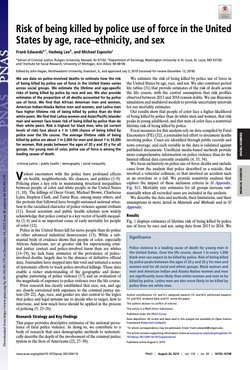By John M. Violanti and Andrea Steege
Purpose –—The purpose of this paper is to update the assessment of national data on law enforcement worker suicide based on the National Occupational Mortality Surveillance database (NOMS, Centers for Disease Control and Prevention). Design/methodology/approach –—Death certificate data for 4,441,814 decedents, age 18–90 who died in one of the 26 reporting states were the source of NOMS data. Utilizing proportionate mortality ratios (PMRs), the ratio of suicides in law enforcement occupations in those who are 18– 90 years old with a designated usual occupation was calculated. Findings –—Findings indicate a significantly higher proportion of deaths from suicide for law enforcement officers (PMR = 154, 95% CI = 147–162), compared to all the US decedents in the study population who were employed during their lifetime. Law enforcement personnel are 54% more likely to die of suicide than all decedents with a usual occupation. PMRs were highest for African-Americans, Hispanic males and for females. PMRs were similar for detectives, corrections officers and all law enforcement jobs, when not stratified by race, ethnicity and sex. Research limitations/implications –—Bias may arise because a PMR can be affected by disproportionate increased or decreased mortality from causes of death other than suicide. Practical implications –—A better understanding of the scope of law enforcement suicide can inform policy focused on the planning and initiation of prevention programs. Originality/value –—The use of a national database to study law enforcement worker suicide adds to other information available on law enforcement worker suicide in specific geographic areas. The discussion on prevention in this paper presents ideas for policy
Policing. 2021 ; 44(1): 18–31. doi:10.1108/PIJPSM-09-2019-0157. 16p.




